四年级英语下册第五单元第二课时教案
外研版四年级下册英语Module 5《Unit 2 They were young.》教案
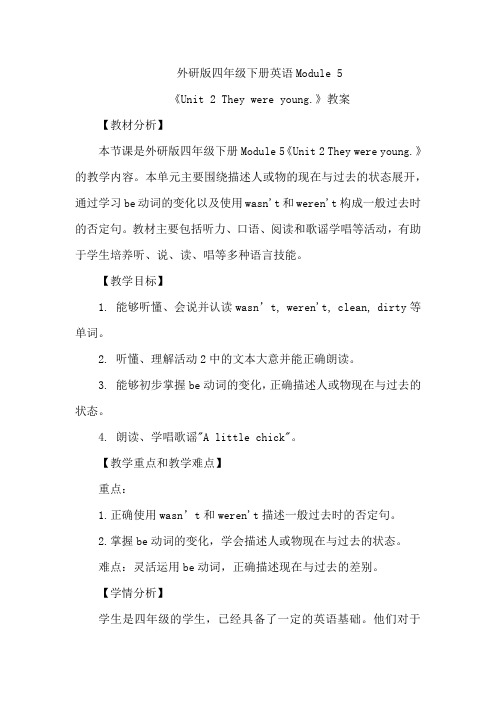
外研版四年级下册英语Module 5《Unit 2 They were young.》教案【教材分析】本节课是外研版四年级下册Module 5《Unit 2 They were young.》的教学内容。
本单元主要围绕描述人或物的现在与过去的状态展开,通过学习be动词的变化以及使用wasn't和weren't构成一般过去时的否定句。
教材主要包括听力、口语、阅读和歌谣学唱等活动,有助于学生培养听、说、读、唱等多种语言技能。
【教学目标】1. 能够听懂、会说并认读wasn’t, weren't, clean, dirty等单词。
2. 听懂、理解活动2中的文本大意并能正确朗读。
3. 能够初步掌握be动词的变化,正确描述人或物现在与过去的状态。
4. 朗读、学唱歌谣"A little chick"。
【教学重点和教学难点】重点:1.正确使用wasn’t和weren't描述一般过去时的否定句。
2.掌握be动词的变化,学会描述人或物现在与过去的状态。
难点:灵活运用be动词,正确描述现在与过去的差别。
【学情分析】学生是四年级的学生,已经具备了一定的英语基础。
他们对于be动词的变化和一般过去时的基本概念有了初步的了解,但可能还不够熟练。
他们对于描述人或物的现在和过去状态可能还存在一定的困惑。
在学习过程中,教师需要提供大量的口语练习和示范,帮助学生加深对语言形式和意义的理解。
同时,通过歌谣学唱的形式,激发学生的学习兴趣,增强记忆和学习英语的乐趣。
【教学过程】Step 1: Warm-up教师与学生互动,问候学生,引发学生对过去和现在的讨论。
教师可以问一些问题,如"What did you do yesterday?"或"What do you usually do after school?",鼓励学生用英语回答。
例子:Teacher: Good morning, everyone! How are you today? Let's talk about what we did yesterday. Jack, what did you do yesterday after school?Jack: I played soccer with my friends in the park.Teacher: That sounds fun! How about you, Sarah? What did you do yesterday?Step 2: Presentation教师出示图片,包括一些描述人或物的现在和过去状态的场景,例如:一个脏的房间和一个干净的房间。
四年级英语下册第五单元第二课时教案
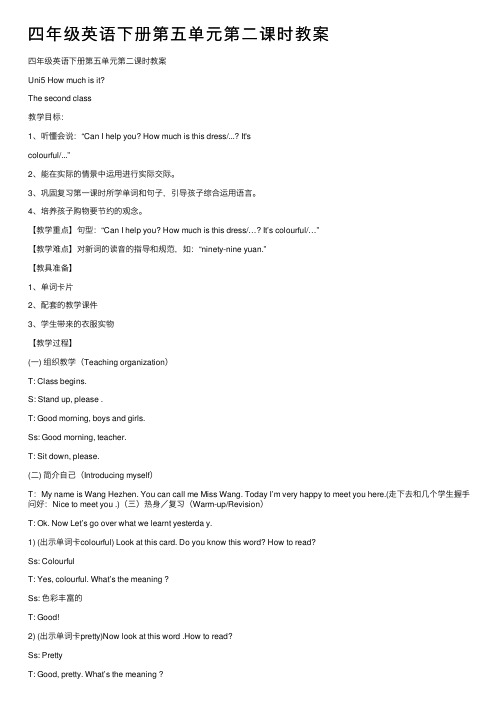
四年级英语下册第五单元第⼆课时教案四年级英语下册第五单元第⼆课时教案Uni5 How much is it?The second class教学⽬标:1、听懂会说:“Can I help you? How much is this dress/...? It'scolourful/...”2、能在实际的情景中运⽤进⾏实际交际。
3、巩固复习第⼀课时所学单词和句⼦,引导孩⼦综合运⽤语⾔。
4、培养孩⼦购物要节约的观念。
【教学重点】句型:“Can I help you? How much is this dress/…? It’s colourful/…”【教学难点】对新词的读⾳的指导和规范,如:“ninety-nine yuan.”【教具准备】1、单词卡⽚2、配套的教学课件3、学⽣带来的⾐服实物【教学过程】(⼀) 组织教学(Teaching organization)T: Class begins.S: Stand up, please .T: Good morning, boys and girls.Ss: Good morning, teacher.T: Sit down, please.(⼆) 简介⾃⼰(Introducing myself)T:My name is Wang Hezhen. You can call me Miss Wang. Today I’m very happy to meet you here.(⾛下去和⼏个学⽣握⼿问好:Nice to meet you .)(三)热⾝/复习(Warm-up/Revision)T: Ok. Now Let’s go over what we learnt yesterda y.1) (出⽰单词卡colourful) Look at this card. Do you know this word? How to read?Ss: ColourfulT: Yes, colourful. What’s the meaning ?Ss: ⾊彩丰富的T: Good!2) (出⽰单词卡pretty)Now look at this word .How to read?Ss: PrettyT: Good, pretty. What’s the meaning ?Ss: 漂亮的T: Right.3) (出⽰单词卡cheap)Now look at this word. Please read!Ss: Cheap.T: Yes, cheap. You are very good. What’s the meaning ?Ss: 便宜的T: Yes , You are right.4)(出⽰单词卡expensive) Now look at this word. How to read?Ss: Expensive.T: You are great.5)(出⽰价格¥60)Now look at this card. Ask: How much?Ss: Sixty yuan.T: Good. Sixty yuan6)(出⽰价格¥71)Ask: How much?Ss: Seventy-one yuan.T: Good. Seventy-one yuan.7)(出⽰绿纸裙)Ask:What’s this?Ss: Dress.T: How much? Guess! (让学⽣去猜)T: Now let’s have a look.(从纸裙后⾯拿出吊牌价给学⽣看,引导学⽣说……) T&Ss: Oh It’s 23 yuan .8)(出⽰红纸裙)Ask:How much is this dress? (让学⽣去猜)T:Now let’s have a look. (从纸裙后⾯拿出吊牌价给学⽣看,引导学⽣说……) T&Ss: Oh It’s 100 yuan.9) (举起纸裙启发学⽣说)So this dress is cheap.And this dress is expensive.10)(举起蓝纸裙)Ask: Who likes this dress? Put up your hands. (⿎励学⽣举⼿,把纸裙送给先举⼿的同学并说Here you are.)11)(举起红纸裙)Ask: Who likes this dress? (动作⽰意,⿎励学⽣举⼿,把纸裙送给先举⼿的同学并说Here you are.)12)Ok. Now let’s play a game “Find friends”过程:找四位同学上来,把刚才的四张卡⽚分别发给他们并说Here you are.好,现在请这两位同学上来为他们⼿中的裙⼦的价格找⼀个合适“朋友”好吗? (然后让这两位同学把抽到的单词卡拿给同学们看,让同学们看看他们是否找对了朋友:¥23---cheap¥100---expensive)T: Oh, this dress is 23 yuan . It is cheap. This dress is 100 yuan, It is expensive. Ok. Clap for them.(给学⽣以奖励)13)(复习结束)Say:OK, so much for this .Now we are going to learn Unit5Ho w much is it? The second class Let’s talk. OK?(四)呈现新课(Presentation)1) Say :At first,look at the screen.(点击幻灯⽚3)展⽰三条裙⼦给学⽣并问What can you see?Ss:Dress.T: How beautiful! Right?Look at that dress. It’s colourful.It’s pretty. Right?Do you want to buy?(想买吗?)Ss: Yes./(想)(插⼊汉语)好,接下来我们⼀起来看看今天到底谁最想买这条裙⼦。
英语人教版四年级下册unit5第二课时教学设计
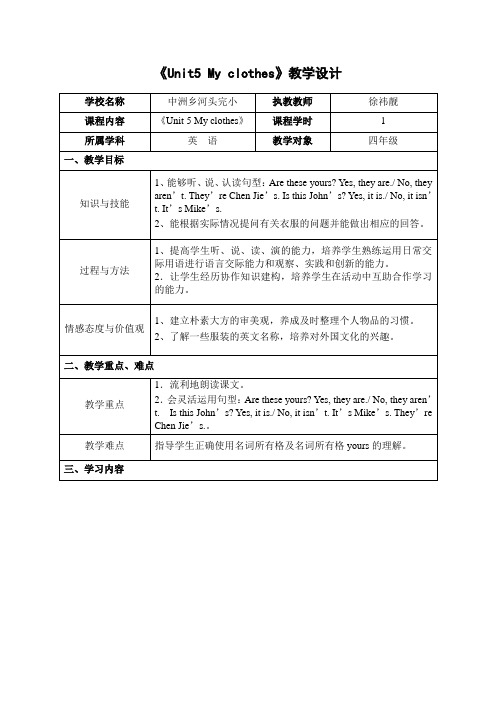
共享 论证
出示图片 自由抢答、齐答。 检查单词掌握情况, 巩固和拓 互问互练习。 展句型
课件
熟练掌握 基本句型
共享 论证
课文中怎么表达所有关系?
默读课文,小组讨论, 交流总结。
课件
学习合作 探究, 了解 重点知识 点 通过课堂 创设语境, 学习应用
共享 论证
出示图片, 进行小组合作的问 小组合作,熟练巩固 答练习。
知识与技能
过程与方法
情感态度与价值观
二、教学重点、难点 1.流利地朗读课文。 教学重点 2. 会灵活运用句型: Are these yours? Yes, they are./ No, they aren’ t. Is this John’s? Yes, it is./ No, it isn’t. It’s Mike’s. They’re Chen Jie’s.。 指导学生正确使用名词所有格及名词所有格 yours 的理解。
共享
1、激趣导入 Sing a song 2、单词游戏。 1、生跟唱歌曲。 3、学生听录音做动作或者听 2、学生借助活动复习 教师、 同学指令做动作, 复习 已学单词。 巩固上单元所学习的内容, 为 后面的学习做好准备。
课件
激发兴趣 了解课题
活动 2:趣味练习,掌握问答 CKB 教师活动 学生活动 资源/工具 活动成果
教学难点 三、学习内容
本课以课文为基础,学习英语语言交流方式,锻炼应用交流能力。 学生学习内容: (1) 、熟练掌握单词和句型,能理解对话大意;能用正确的语音语调朗读对话; (2) 、在精读课文中,能结合语境中理解新词 yours,Chen Jie’s,Mike’s 的意思, 并正确发音。 (3) 、能根据实际情况提问有关衣服的归属问题并能做出相应的回答。 (4) 、能根据具体的情景运用所学知识进行对话,拓展用英语语言交际的能力。
四年级下册英语教学设计-Unit 5 Free Time Lesson 2 (2)∣人教新起点

四年级下册英语教学设计-Unit 5 Free Time Lesson 2 (2)
一、教学目标
知识目标:
1.能够正确听、说、写单词和短语:read, book, computer, game, watch TV, listen to music, play chess, draw pictures。
2.能够通过问答句型表达自己在闲暇时间中喜欢做的事情,并学会运用回答交流与他人。
能力目标:
1.培养学生良好的听、说、读、写英语语言运用能力,提高其英语综合语言沟通能力。
2.培养并提高学生与人进行交际的能力。
情感目标:
1.培养学生积极主动、自信的学习态度和乐观向上的情感态度。
2.培养学生热爱生活、热爱学习英语的习惯。
二、教学重难点
教学重点:
1.学会正确听、说、读、写本课单词和短语。
2.学会正确理解并准确运用句型:“What do you like doing in your free time?” “I like reading books/computers/games/watching TV/listening to music/playing chess/drawing pictures.”
教学难点:
1.能够准确理解并灵活运用所学的句型。
2.能够在熟练掌握句型的基础上,表达出自己喜欢做的事情。
三、教学准备
1.PPT。
2.课件及相关实物:书、电脑、游戏、电视、音乐、国际象棋、铅笔、纸等。
四、教学过程
1. Warm-up
1.Greeting: Good morning, children!
2.Sing the song。
小学英语四年级下册第二模块第五单元第二课时优秀教案

单元教学设计框架课题:牛津英语小学四年级下册Module 2 Unit 5 Sport (Period 2)一、学情分析小学四年级下学期学生处于中年级向高年级过渡时期,形象思维依然是主导,好奇心强,思维更为开阔。
逻辑思维初步形成,老师应注重引导学生从中低年级的以语言模仿为主的英语学习方式逐渐过渡到语言运用的方式,开发学生思维。
既注重学生的形象思维,同样注重学生英语学习逻辑思维的培养,开发学生的发散性思维。
但由于特殊是时期,网络课成为学生学习的主要方式,师生之间的互动很难实现,教师要特别注重在课程设计时前后的逻辑连贯性和思维启发性,通过游戏、歌曲、歌谣、视频等方式吸引学生的注意力,充分调动在较短时间内的参与度和学习兴趣,从而尽可能达到网络课学习的效率与质量。
二、教材分析:本单元内容属于教材的模块二My favorite things, 在本册教材中有着承上启下的作用, 是根据学生身心发展后去鼓励学生关注自己的发展和关注身边朋友,主要教授学生学会用英语表达喜爱的运动,引导学生热爱运动,强身健体。
在此前英语学习中,学生已经学习过如何表达去表达自己的喜好,如I like...,也学会询问别人的喜好,如What do you like? What does he/she like?从中延伸出来的新的句型是本单元的句型结构Does he/she like doing...? Yes,he/ she does. 学生比较熟悉,大部分重点词汇,如football,basketball,volleyball都是学生在以往的学习拓展中接触过的,学生比较喜爱、熟悉本单元的话题和知识。
在本单元第一、二课时的教学涉及中,重点学习句型如下:I like playing...He/she likes playing...Does Alice like playing...?Yes, she does.重点单词如下:sport, football, basketball, volleyball,football, join, us, club, 因此,在本单元第三课时的重点在于Say and act 部分的语篇中摘取的重难点句型Would you like to do...Yes, I’d like to...No, sorry.为了丰富语篇表达,在此句型的基础上,拓展出新的内容和运动意义,并且在第四课时鼓励学生介绍自己最喜欢的运动和运动意义,激趣促进学生的思考和书写能力,也同时提高综合语用能力。
小学四年级英语下册《Unit5 第二课时》示范课教学设计
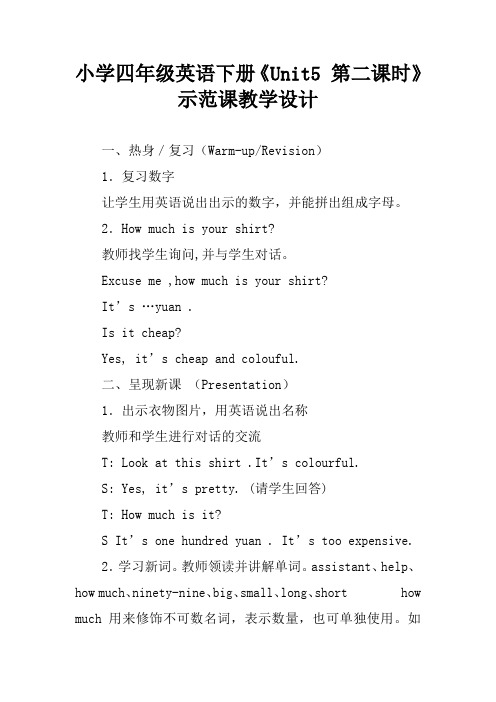
小学四年级英语下册《Unit5 第二课时》示范课教学设计一、热身/复习(Warm-up/Revision)1.复习数字让学生用英语说出出示的数字,并能拼出组成字母。
2.How much is your shirt?教师找学生询问,并与学生对话。
Excuse me ,how much is your shirt?It’s …yuan .Is it cheap?Yes, it’s cheap and colouful.二、呈现新课(Presentation)1.出示衣物图片,用英语说出名称教师和学生进行对话的交流T: Look at this shirt .It’s colourful.S: Yes, it’s pretty. (请学生回答)T: How much is it?S It’s one hundred yuan . It’s too expensive.2.学习新词。
教师领读并讲解单词。
assistant、help、how much、ninety-nine、big、small、long、short how much用来修饰不可数名词,表示数量,也可单独使用。
如milk, money (钱),water,等等;How many用来修饰可数名词的复数,如 apples , shirts, pens 等等;两组反义词:small——big long——short3.让学生观察P59三张图片,理解内容,并讲解。
再看一遍,边看边模仿故事中人物的语气说一说。
并让学生扮演不同的任务进行对话。
4.出示图片,练习How much is it?句型,并判断价格的高低。
5.Group work 出示购物的相关对话,及仿照Let’s talk部分中的对话。
让孩子们仿照相关的对话,进行购物活动。
新版PEP英语四年级下册第五单元第二课时教案
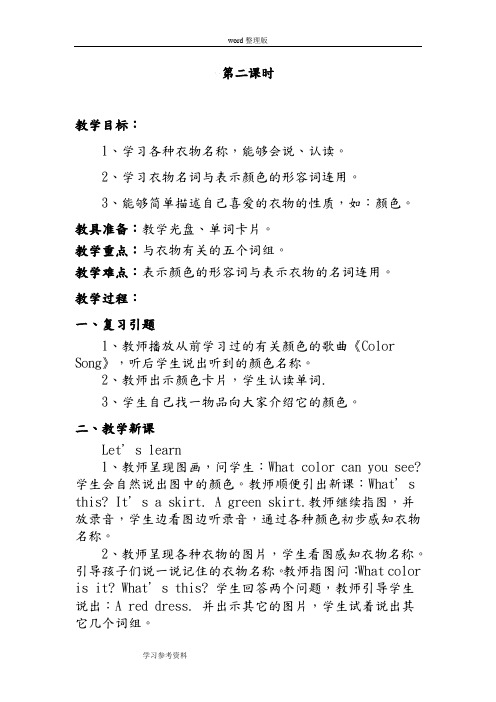
第二课时教学目标:1、学习各种衣物名称,能够会说、认读。
2、学习衣物名词与表示颜色的形容词连用。
3、能够简单描述自己喜爱的衣物的性质,如:颜色。
教具准备:教学光盘、单词卡片。
教学重点:与衣物有关的五个词组。
教学难点:表示颜色的形容词与表示衣物的名词连用。
教学过程:一、复习引题1、教师播放从前学习过的有关颜色的歌曲《Color Song》,听后学生说出听到的颜色名称。
2、教师出示颜色卡片,学生认读单词.3、学生自己找一物品向大家介绍它的颜色。
二、教学新课Let’s learn1、教师呈现图画,问学生:What color can you see? 学生会自然说出图中的颜色。
教师顺便引出新课:What’s this? It’s a skirt. A green skirt.教师继续指图,并放录音,学生边看图边听录音,通过各种颜色初步感知衣物名称。
2、教师呈现各种衣物的图片,学生看图感知衣物名称。
引导孩子们说一说记住的衣物名称。
教师指图问:What color is it? What’s this? 学生回答两个问题,教师引导学生说出:A red dress. 并出示其它的图片,学生试着说出其它几个词组。
3、看书中图并放录音,学生边看图边听录音感知并理解句子,用动作帮助学生理解单词with的用法所表示的意思。
4、找几个学生到前边来当模特,再请两个同学来表演刚学的两句话。
(或者播放课件,学生配音)Let’s do1、教师播放录音或录像,带领学生做游戏。
2、教师发布指令,学生做动作;一学生发布指令,教师和其他学生一起做动作。
3、小组比赛,每人听一个指令做动作,接力进行,看那个小组动作做得正确。
奖励优胜组。
4、两人一组互相快速发布指令并做动作,到前边进行表演。
三、巩固练习1、让学生介绍自己的衣服颜色及名称,或者喜欢谁的衣服就介绍谁的衣服。
四、布置作业1、读课文第39页并背诵 Let's do。
五、板书设计Unit 5 My clothesWhat color can you see?What’s this? It’s a skirt. A green skirt.apple, people, table。
人教PEP版四年级英语下册Unit 5单元教案(精选5篇)

人教PEP版四年级英语下册Unit 5单元教案(精选5篇)人教PEP版四年级英语下册Unit 5单元教案篇1教学目标:1.能力目标(1)能够理解对话大意。
(2)能够运用正确的语音、语调朗读对话。
(3)能在实际情境中运用所学主句型,How old are you? I’m …years old. 询问年龄并作答。
(4)能用Happy birthday!向别人表达生日祝福。
2.知识目标(1)听懂、会说句子How old are you? I’m…。
Happy birthday!(2) 听、说单词six, brother.3.文化目标(1)渗透:当你收到别人的礼物和祝福时,要说“Thank you”(2)提示学生在西方国家,成年人一般不谈论年龄的话题,这属于个人隐私。
教学重点:听懂、会说Happy birthday! How old are you? I’m…教学难点:(1) How old are you? 与How are you? 的区分,以及所学内容的灵活运用。
(2)单词brother的读音。
教学过程:Step1 Preparation1. Free talkT: Hello! How are you? Nice to meet you .2. ChantT: First , Let’s have a chant.P.59页设计意图:和数字有关的chant既能活跃课堂气氛,又能复习数字。
3. 创设情境。
(播放生日音乐)T: Listen, what’s happening?出示幻灯片生日,Oh , here’s a birthday party .Look, so many gifts .What are they? Let’s have a look .Let’s count . How many…?借助课件,引出six并借助卡片教学。
设计意图:尽快的创设情境,在生日party 中复习旧知,并以旧带新,解决新单词。
四年级下册英语教案-Module 5 Unit 2 He's drawing books and b

四年级下册英语教案-Module 5 Unit 2 He’s drawing booksand birds ∣外研社(一起)教学目标1.能够听懂、会说、会读、会拼写以下单词及句子:–drawing–books–birds–What’s he doing?–He’s drawing books and birds.2.能够正确运用句型What’s he doing? 和He’s drawing books and birds. 进行简单的交际。
教学重点1.能够听懂、会说、会读、会拼写单词 drawing, books, birds,并能够正确理解句型He’s drawing books and birds.2.能够正确运用句型What’s he doing? 和He’s drawing books and birds. 进行简单的交际。
教学难点1.能够准确使用句型He’s drawing books and birds. 进行简单的交际。
2.能够通过听力完整地理解并获取语言信息。
教学准备1.教材:外研社《英语一起》四年级下册 Module 5 Unit 22.教具:PPT、图片、单词卡片、录音机、黑板、彩笔。
教学过程1. Warm up1.安排几组学生,每组指定一名学生为“演员”,此人需要在黑板上进行简单的绘画表演,其余学生通过观察、听和口头表述来猜测演员正在画的是什么。
2. Presentation1.展示图片(书籍、鸟类和画笔),引导学生口头表述所见物品,并通过图片和单词卡片的搭配教授单词 drawing,books 和 birds。
2.向学生展示一张图片(人物画画的场景),口头表达What’s he doing?并通过反复口头表述和实际演示让学生理解该句型。
3.输入句型He’s drawing books and birds. 并反复展示图片向学生演示该句型的使用场景,加深学生对该句型的理解。
PEP四年级下Unit5 Part A 第二课时教学设计
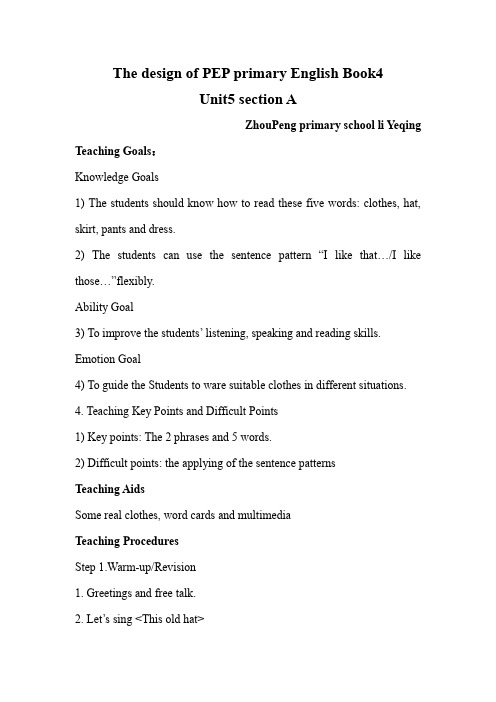
The design of PEP primary English Book4Unit5 section AZhouPeng primary school li Yeqing Teaching Goals:Knowledge Goals1) The students should know how to read these five words: clothes, hat, skirt, pants and dress.2) The students can use the sentence pattern “I like that…/I like those…”flexibly.Ability Goal3) To improve the students’ listening, speaking and reading skills. Emotion Goal4) To guide the Students to ware suitable clothes in different situations. 4. Teaching Key Points and Difficult Points1) Key points: The 2 phrases and 5 words.2) Difficult points: the applying of the sentence patternsTeaching AidsSome real clothes, word cards and multimediaTeaching ProceduresStep 1.Warm-up/Revision1. Greetings and free talk.2. Let’s sing <This old hat>3. Let’s talk APurpose: Free talk can quickly get the students into an English speaking state. And singing English song can arouse interests of learning new contents. The revision of last lesson can make Students feel relaxed. Step 2.Presentation and practicePresent the 5 new wordsI’ll hang up different kinds of clothes that we will learn on the blackboard. Teach the word “clothes”. Teacher creates a situation of Fashion Show. Guide students choose their favorite clothes and pretend to be a model. Teacher stick corresponding word cards on their clothes.Purpose: To find another way to explain the meaning of the words, not just to translate them into Chinese, let the students understand the meaning of the words from a real situation.1.Teach the new wordsTeach “skirt” and “hat”, the two little models who wear them stand on the platform and other students follow teacher read the two words. Then teacher show occluded object on courseware, students play guessing game by saying “skirt” or “hat” in pairs.Teach “dress” and “pants”, teach these two new words in the same way, and emphasize plural. Students play the game “Opposite tune”.Purpose: Integrate the learning of new words in to the context, deepen the impression of students, is conducive to memory.3. Language practiceTeacher show the two sentences on blackboard, and emphasis “those” is the plural of “that”. Students follow teacher read the two sentences: “I like that skirt. I like those pants.” In order to make the language prac tice full of fun, I design some games.1)Eyes and earsThe students watch the mouthing shapes of the teacher, guess and say out the correspondent sentences.2) WhisperPut the whole class into several groups according to longitudinal rows.The teacher gives the one who sits back in each group a piece of paper. There is one sentence “I like……” on each of it. The students sitting in the back whisper the sentence to the front, and the front to the front. The last student in each group speaks out what their group whispers. In the end, the fastest and the most accurate group win.Purpose: Game is one of the most effective ways to practice English for pupils which can mobilize all the students in the class.Step 3. Consolidation and extension1. Choose the suitable clothesAsk the students work in groups and try to choose the suitable clothes in different situations.2. Let's join in the Fashion Show together.Guide Students design their own favorite clothes to join in the Fashion Show. And try to introduce their clothes by using the sentence patterns we have learned. For example: This is my favorite clothes. I like green skirt. It makes me looks beautiful…….Purpose: This design is an overall presentation of the contents.Step 4. Summary and Homework (3-5 min)1) Read the new words and sentences aloud.2) Design clothes by yourselves and try to describe it in English.Purpose: I design the homework to satisfy the needs of the students in different levels and in order to give the students a better and clearerunderstanding of this lesson.Here is my blackboard design.Preview task:Preview the contents of“Let’s spell”。
四年级英语下册 Unit5 第2课时教案 人教PEP
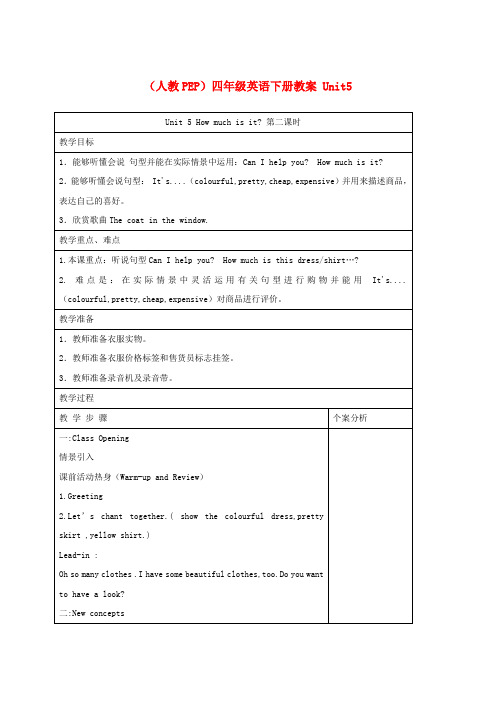
Oh so many clothes .I have some beautiful clothes,too.Do you want to have a look?
二:New concepts
1.新知呈现:
T:(教师拿出dress)Look,what’s this?Yes,it’s a dress. Is it nice ? Yes,it’s very nice . It’s very expensive .Guess.
S1: I’m here. Can I help you?
T: Yes,I want to buy a shirt . How much is it?
S1:It’s 50 yuan .
T: Oh,it’s 50 yuan .Too expensive! 30 yuan,OK?
S1:OK.
T:I’ll take it .
4.自学:
T:Read your books and circle the words or sentences your don’t understand .
小组交流
5.质疑答疑:
Are there any questions ?(discuss:too、very;an assistant)
6.(1)Read and follow .
(2)Read by themselves.
(3)Check for the reading.
三.语言实践
T:Class,Amy’s clothes are very expensive. What about yours ? Let’s make a survey like this.
示范:Hello,how much is your coat?
四年级下册Unit 5第二课时教案
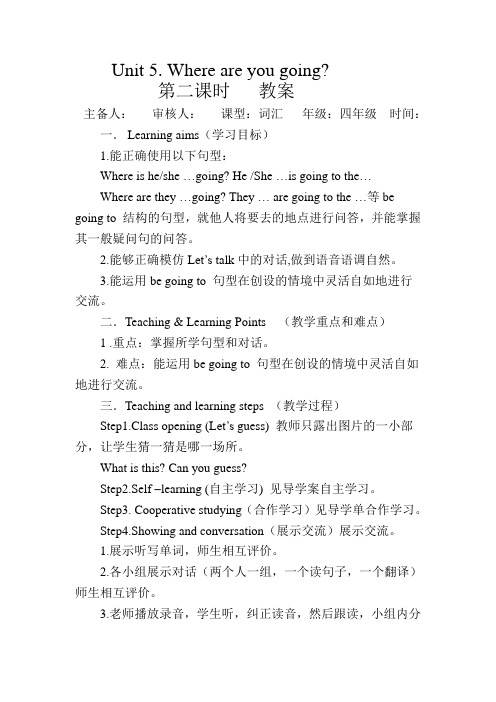
Unit 5. Where are you going?第二课时教案主备人:审核人:课型:词汇年级:四年级时间:一.Learning aims(学习目标)1.能正确使用以下句型:Where is he/she …going? He /She …is going to the…Where are they …going? They … are going to the …等be going to 结构的句型,就他人将要去的地点进行问答,并能掌握其一般疑问句的问答。
2.能够正确模仿Let’s talk中的对话,做到语音语调自然。
3.能运用be going to 句型在创设的情境中灵活自如地进行交流。
二.Teaching & Learning Points (教学重点和难点)1 .重点:掌握所学句型和对话。
2. 难点:能运用be going to 句型在创设的情境中灵活自如地进行交流。
三.Teaching and learning steps (教学过程)Step1.Class opening (Let’s guess) 教师只露出图片的一小部分,让学生猜一猜是哪一场所。
What is this? Can you guess?Step2.Self –learning (自主学习) 见导学案自主学习。
Step3. Cooperative studying(合作学习)见导学单合作学习。
Step4.Showing and conversation(展示交流)展示交流。
1.展示听写单词,师生相互评价。
2.各小组展示对话(两个人一组,一个读句子,一个翻译)师生相互评价。
3.老师播放录音,学生听,纠正读音,然后跟读,小组内分角色朗读对话表演。
4.各小组在班级表演对话。
Step5.Guiding and promoting (点拨提升) 点拨提升1.对Where are you going ? I am going to the … /We are going to the.. 的拓展问他人要去的地点进行问答–Where is...going ? …is going to the…Where are…going? … are going to the …2. 对一般疑问句形式:Is he /she …going to the …? Arethey …going to the …? Yes,…/ No,…的变换练习。
最新人教PEP版小学英语四年级下册Unit5第2课时优质课教学设计
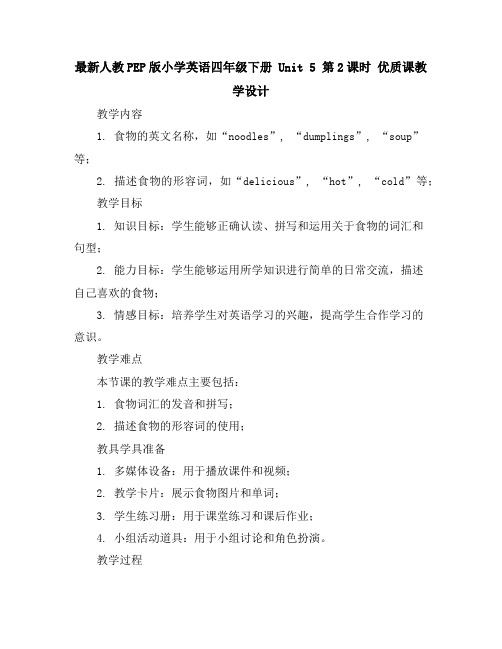
最新人教PEP版小学英语四年级下册 Unit 5 第2课时优质课教学设计教学内容1. 食物的英文名称,如“noodles”, “dumplings”, “soup”等;2. 描述食物的形容词,如“delicious”, “hot”, “cold”等;教学目标1. 知识目标:学生能够正确认读、拼写和运用关于食物的词汇和句型;2. 能力目标:学生能够运用所学知识进行简单的日常交流,描述自己喜欢的食物;3. 情感目标:培养学生对英语学习的兴趣,提高学生合作学习的意识。
教学难点本节课的教学难点主要包括:1. 食物词汇的发音和拼写;2. 描述食物的形容词的使用;教具学具准备1. 多媒体设备:用于播放课件和视频;2. 教学卡片:展示食物图片和单词;3. 学生练习册:用于课堂练习和课后作业;4. 小组活动道具:用于小组讨论和角色扮演。
教学过程1. 导入:通过展示食物图片,引导学生复习已学的食物词汇,激发学生学习兴趣;2. 新课呈现:教师通过课件和教学卡片,教授新单词和句型,并进行示范;3. 操练:学生进行小组活动,运用所学知识进行角色扮演和问答练习;4. 巩固:教师通过游戏和竞赛,巩固学生所学知识;6. 作业布置:教师布置课后作业,巩固所学知识。
板书设计1. 本节课的主题:食物;2. 重点词汇和句型;3. 课堂练习和课后作业。
作业设计1.抄写本节课所学的食物词汇和句型;2. 完成练习册上与本节课内容相关的练习;3. 运用所学知识,与家长进行简单的英语交流,描述自己喜欢的食物。
课后反思重点关注的细节是“教学过程”,因为这是课堂教学的核心部分,直接关系到教学目标能否实现,教学难点能否突破,以及学生的学习效果。
教学过程详细补充和说明1. 导入情景创设:利用多媒体播放一段小学生在家中与父母讨论晚餐食物的短片,短片中的角色用英语表达对食物的喜好。
复习旧知:通过快速问答的形式复习上一课时学过的食物词汇,为新课的学习做好铺垫。
译林版(三起)四年级下册英语教案:Unit 5 Seasons 第二课时

译林版(三起)四年级下册英语教案:Unit 5 Seasons 第二课时一、教学目标1.学会四个季节的单词:spring, summer, autumn, winter。
2.学会表达喜欢的季节和原因:I like… because…。
3.学会询问他人喜欢的季节:What season do you like?4.练习听力和口语能力。
二、教学重点1.如何正确地表达自己喜欢的季节并且提供原因。
2.如何听懂和回答问题:What season do you like?三、教学准备1.学生手册和听力材料2.学生本人最喜欢的季节图片3.教师准备一些图片或者视频资料展示四季的不同之处。
四、教学过程a. 导入在黑板上出示一幅图片展示四季的不同之处,提示学生对于四季有一个基本的认识。
然后教师将自己选择的季节的图片展示出来,问学生们自己最喜欢的季节是什么,为什么?听学生回答之后老师再说自己最喜欢的季节及原因。
b. 学习单词学生翻到课本第几页(74页),跟着老师一起读,并拼读四个季节的单词:“spring, summer, autumn, winter”。
然后老师会提供一些例句,帮助学生更加深入理解这些单词的含义。
c. 看图说话每个学生向教室里展示提前准备好的自己最喜欢的季节的图片,并用一两句话来描述这个季节。
老师可以在学生的描述中提供一些建议,以便学生更好地表达他们的想法。
d. 听力活动老师向学生播放一段关于四季的听力材料,并要求他们听懂问题,并回答问题:“What season do you like?”,帮助他们熟悉这个常用短语。
e. 生活借鉴让学生讲述他们所熟悉的某些季节的活动和传统,例如夏天的烧烤、冬天的滑雪等等,让学生向其他同学展示和介绍这些活动和传统,以帮助他们更好地了解四季和不同文化间的差异。
f. 总结老师在总结课程时,可以帮助学生更好地理解和总结所学的这些内容。
要求学生总结出每季所做的事情并且可以将这些内容整合到一篇短文中。
四年级下册英语教案-Module5 Unit2 They were young(外研版)
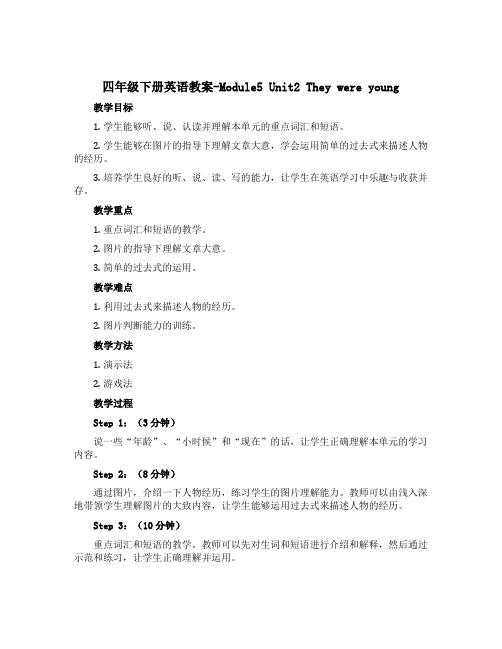
四年级下册英语教案-Module5 Unit2 They were young教学目标1.学生能够听、说、认读并理解本单元的重点词汇和短语。
2.学生能够在图片的指导下理解文章大意,学会运用简单的过去式来描述人物的经历。
3.培养学生良好的听、说、读、写的能力,让学生在英语学习中乐趣与收获并存。
教学重点1.重点词汇和短语的教学。
2.图片的指导下理解文章大意。
3.简单的过去式的运用。
教学难点1.利用过去式来描述人物的经历。
2.图片判断能力的训练。
教学方法1.演示法2.游戏法教学过程Step 1:(3分钟)说一些“年龄”、“小时候”和“现在”的话,让学生正确理解本单元的学习内容。
Step 2:(8分钟)通过图片,介绍一下人物经历,练习学生的图片理解能力。
教师可以由浅入深地带领学生理解图片的大致内容,让学生能够运用过去式来描述人物的经历。
Step 3:(10分钟)重点词汇和短语的教学。
教师可以先对生词和短语进行介绍和解释,然后通过示范和练习,让学生正确理解并运用。
Step 4:(20分钟)以游戏的方式进行词语和短语的复习,并让学生在游戏过程中运用所学知识。
比如“躲猫猫”游戏:学生分为两组,一组学生隐藏,另一组学生寻找,教师可以视情况出一些提示,让学生按照提示找到藏匿学生。
Step 5:(12分钟)让学生进行小组活动,让小组中的学生依次讲述自己的家人、朋友等人物的经历,让其他小组成员运用所学知识进行短暂的讨论。
Step 6:(5分钟)总结教学内容。
回顾本节课所学知识点,对本节课的学习内容进行归纳和概括,并对今后的学习方向进行简要介绍,构思教学中的下一步内容。
教学反思本节课的教学内容主要围绕重点词汇和短语展开,通过图片和游戏的方式让学生将学习内容更加深入地理解,让学生在语言学习中能够乐趣与收获并存。
当然,我们在教学中也要注意相应方法和步骤的选择,力求将课堂效果最大化,让学生获得更好的知识和能力的提升。
四年级英语下册WY Module 5 Unit 2 They were young优秀教案
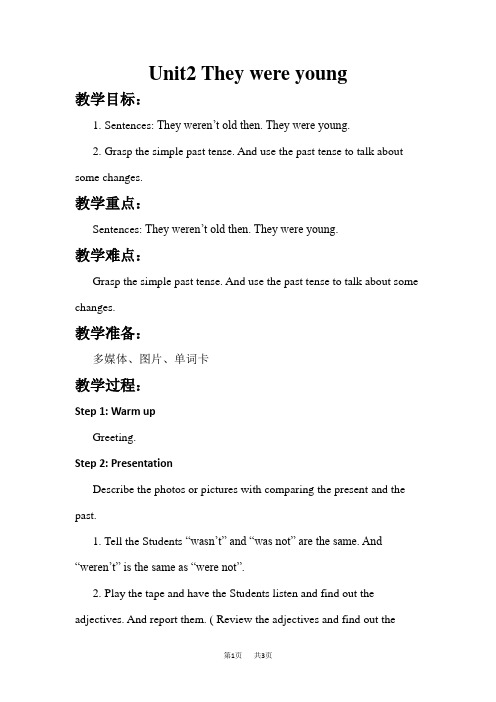
Unit2 They were young教学目标:1. Sentences: They weren’t old then. They were young.2. Grasp the simple past tense. And use the past tense to talk about some changes.教学重点:Sentences: They weren’t old then. They were young.教学难点:Grasp the simple past tense. And use the past tense to talk about some changes.教学准备:多媒体、图片、单词卡教学过程:Step 1: Warm upGreeting.Step 2: PresentationDescribe the photos or pictures with comparing the present and the past.1. Tell the Students “wasn’t”and “was not” are the same. And “weren’t” is the same as “were not”.2. Play the tape and have the Students listen and find out the adjectives. And report them. ( Review the adjectives and find out thedifferences)3. Learn the chant.First, get the Students to look at the pictures and describe them.( A small chick and two big fat hens.) Then play the spoken version of the chant and get the Students to repeat the words then chant.Step 3: Teacher-student interaction1. Have the students do Part5.Look at the pictures. Compare “now” and “then”. Then describe the pictures. (Cultivate the Students’ oral English.)2. Have the students to show and talk about their photos.3. Play a game.Have the Students work in groups. S1 will act out S2 who was in many years ago. Then S3 will introduce the two Students. Find out some changes with the past and present tense.板书设计:教学反思:Unit2 They were youngThey weren’t old then. weren’t →were not Th ey were young. wasn’t → was not A: Was it fat?B: No, it wasn’t. It’s thin.。
- 1、下载文档前请自行甄别文档内容的完整性,平台不提供额外的编辑、内容补充、找答案等附加服务。
- 2、"仅部分预览"的文档,不可在线预览部分如存在完整性等问题,可反馈申请退款(可完整预览的文档不适用该条件!)。
- 3、如文档侵犯您的权益,请联系客服反馈,我们会尽快为您处理(人工客服工作时间:9:00-18:30)。
四年级英语下册第五单元第二课时教案Uni5 How much is it?The second class教学目标:1、听懂会说:“Can I help you? How much is this dress/...? It'scolourful/...”2、能在实际的情景中运用进行实际交际。
3、巩固复习第一课时所学单词和句子,引导孩子综合运用语言。
4、培养孩子购物要节约的观念。
【教学重点】句型:“Can I help you? How much is this dress/…? It’s colourful/…”【教学难点】对新词的读音的指导和规范,如:“ninety-nine yuan.”【教具准备】1、单词卡片2、配套的教学课件3、学生带来的衣服实物【教学过程】(一) 组织教学(Teaching organization)T: Class begins.S: Stand up, please .T: Good morning, boys and girls.Ss: Good morning, teacher.T: Sit down, please.(二) 简介自己(Introducing myself)T:My name is Wang Hezhen. You can call me Miss Wang. Today I’m very happy to meet you here.(走下去和几个学生握手问好:Nice to meet you .)(三)热身/复习(Warm-up/Revision)T: Ok. Now Let’s go over what we learnt yesterda y.1) (出示单词卡colourful) Look at this card. Do you know this word? How to read?Ss: ColourfulT: Yes, colourful. What’s the meaning ?Ss: 色彩丰富的T: Good!2) (出示单词卡pretty)Now look at this word .How to read?Ss: PrettyT: Good, pretty. What’s the meaning ?Ss: 漂亮的T: Right.3) (出示单词卡cheap)Now look at this word. Please read!Ss: Cheap.T: Yes, cheap. You are very good. What’s the meaning ?Ss: 便宜的T: Yes , You are right.4)(出示单词卡expensive) Now look at this word. How to read?Ss: Expensive.T: You are great.5)(出示价格¥60)Now look at this card. Ask: How much?Ss: Sixty yuan.T: Good. Sixty yuan6)(出示价格¥71)Ask: How much?Ss: Seventy-one yuan.T: Good. Seventy-one yuan.7)(出示绿纸裙)Ask:What’s this?Ss: Dress.T: How much? Guess! (让学生去猜)T: Now let’s have a look.(从纸裙后面拿出吊牌价给学生看,引导学生说……) T&Ss: Oh It’s 23 yuan .8)(出示红纸裙)Ask:How much is this dress? (让学生去猜)T:Now let’s have a look. (从纸裙后面拿出吊牌价给学生看,引导学生说……) T&Ss: Oh It’s 100 yuan.9) (举起纸裙启发学生说)So this dress is cheap.And this dress is expensive.10)(举起蓝纸裙)Ask: Who likes this dress? Put up your hands. (鼓励学生举手,把纸裙送给先举手的同学并说Here you are.)11)(举起红纸裙)Ask: Who likes this dress? (动作示意,鼓励学生举手,把纸裙送给先举手的同学并说Here you are.)12)Ok. Now let’s play a game “Find friends”过程:找四位同学上来,把刚才的四张卡片分别发给他们并说Here you are.好,现在请这两位同学上来为他们手中的裙子的价格找一个合适“朋友”好吗? (然后让这两位同学把抽到的单词卡拿给同学们看,让同学们看看他们是否找对了朋友:¥23---cheap¥100---expensive)T: Oh, this dress is 23 yuan . It is cheap. This dress is 100 yuan, It is expensive. Ok. Clap for them.(给学生以奖励)13)(复习结束)Say:OK, so much for this .Now we are going to learn Unit5Ho w much is it? The second class Let’s talk. OK?(四)呈现新课(Presentation)1) Say :At first,look at the screen.(点击幻灯片3)展示三条裙子给学生并问What can you see?Ss:Dress.T: How beautiful! Right?Look at that dress. It’s colourful.It’s pretty. Right?Do you want to buy?(想买吗?)Ss: Yes./(想)(插入汉语)好,接下来我们一起来看看今天到底谁最想买这条裙子。
2)(点击幻灯片4)(指着Amy )T: Who? Ss: Amy. T: Yes.(指着Mom )T: Who? Ss: Amy. T: Yes. (接着说)Now listencarefully . What are they talking? (插入汉语)请同学们认真听,比一比谁最认真,能把他们的话记下来好吗?(点击按钮,让学生听)T:Who can tell me? What are they talking? 鼓励学生举手回答(根据情况可重复播放)Ss: It’s colourful. It’s pretty.(板书It’s colourful.)T:Now let’s look at the dialogue. (点击)Read after me .(Then read together--- read in groups--- read in groups change-- read in pairs.) T: Who volunteer to act out the dialogue? (鼓励学生表演)3)(点击幻灯片5)Look!Who comes? Guess!(插入汉语)我们看看她面带微笑,热情大方的跟Amy的妈妈说话,她会是谁呢?(帮助学生引出assistant并板书该词。
然后教学该词).强调:作为服务员一定要热情大方的对待自己的顾客,积极主动的跟自己的顾客打招呼哦。
下面我们一起来看看这位服务员姐姐是怎样做的?Now listen carefully(动作示意)我们再来比一比谁最认真,能把服务员姐姐的第一句最有礼貌最客气的话记下来,好吗?(点击按钮,让学生听) T:Who can tell me?(谁来告诉老师服务员见到自己的顾客时第一句客气话是什么?)S: Can I help you ?T: Very good! You are great. (给学生以奖励)T:Now listen again. Tell me: How much is this dress?(手指红裙子) (点击按钮,让学生听)T:Who can tell me? How much is this dress?S:It’s n inety-nine yuan.T: Yes, you are great.( (给学生以奖励)T:(点击)Now let’s look at the dialogue. Read after me .(Then read together--- read in groups--- read in groups change-- read in pairs.) T: Who volunteer to act out the dialogue? (鼓励学生表演)(指着红裙子)How much is this dress?Ss:It’s ninety-nine yuan.T: Is it cheap or expensive? Now listen,then answer my question.(点击幻灯片6,让学生听)T:Is this dress cheap or expensive?S: Expensive.T: Good. It’s expensive. (点击)Now look at the dialogue. Read after me. (Then read together--- read in groups--- read in groups change-- read in pairs.)T: Who volunteer to act out the dialogue? (鼓励学生表演)(点击幻灯片7)下面我们把这三幅图放在一起来看看,一起回忆一下今天所学的重要句子。
图1:妈妈看到漂亮裙子时说什么了?Ss:It’s colourful.T: Amy呢?Ss: It’s pretty.图2:服务员见到顾客第一句话怎么说?Ss:Can I help you ?T:妈妈怎样向服务员询问价格?Ss:How much is this dress?图3:觉得衣服很贵怎么表达?Ss:It’s expensive.T:You are great.(点击按钮,让学生看整体对话。
教读--整体读)(五)操练(Practice)A:Can I help you ?B: How much is this dress?A: It’s ninety-nine /…yuan.B: It’s expensive/cheap.(六) 表演(Action)(设置真实情景:把准备的衣物挂起来,设置一个购买衣物的情景)A:Can I help you ?B: How much is this dress?A: It’s ninety-nine /…yuan.B: It’s expensive/cheap.(七) 扩展性活动(Add-activities)1、朗读课文对话给爸爸妈妈听。
